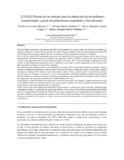Diseño de un método para la obtención de un polímero transformado a partir de poliestireno expandido y biosolventes

Ver / Descargar
Fecha
2022-12-10Autor(es)
Bustos Martínez, Mateo AlejandroSánchez Barbón,Nicolás
Laverde Montero,Yina Lisset
Aguilar Urrego,Silvio Alejandro
Director(es)
Posada Uribe, Luisa FernandaPublicador
Pontificia Universidad Javeriana
Facultad
Facultad de Ingeniería
Programa
Ingeniería Industrial
Título obtenido
Ingeniero (a) Industrial
Tipo
Tesis/Trabajo de grado - Monografía - Pregrado
Compartir este registro
Citación
Documentos PDF
Título en inglés
Design of a method to obtain a transformed polymer from expanded polystyrene and biosolventsResumen
A partir de los entornos altamente consumistas y su creciente demanda de recursos en la actualidad, se evidencia el incremento de producción de los polímeros de un solo uso. Dicho esto, se identifica la necesidad de diseñar un método para la obtención de un polímero transformado a partir del EPS y biosolventes que presente propiedades que permitan modificar su campo de aplicación en la industria.
En primer lugar, se identificaron los procesos de transformación existentes de EPS mediante la revisión de literatura y estado del arte. Definiendo el biosolvente (limoneno y eucaliptol) la temperatura (150°C y 180°C) y el tiempo de proceso (20 min y 30 min) como los factores aplicables en la presente investigación. A partir de esto, se implementa el diseño factorial 2^3 el cual consta de ocho experimentos independientes y dos réplicas por corrida, es decir, dieciséis experimentos en total. Para cada prueba se producen tres probetas para muestreos destructivos.
El desarrollo experimental, inicia con la obtención de EPS posconsumo proveniente de embalaje de electrodomésticos, el cual se tritura para facilitar la disolución del biosolvente. Una vez añadido el biosolvente, se agita la mezcla hasta obtener una consistencia uniforme (se usa etanol al 70% como catalizador de la mezcla). Luego, se usa un molde metálico para calentar la mezcla, una vez finalizado este proceso, se deja enfriar a temperatura ambiente para facilitar el desmolde para finalmente cortar y lijar el material obtenido. Para calcular las variables de respuesta correspondientes a las pruebas mecánicas realizadas de flexión, tensión y compresión, se emplearon los tratamientos normalizados por las normas ASTM.
Posteriormente, se aplica el modelo estadístico del diseño de experimentos factoriales 2^3en lenguaje R y a partir del resultado de las tablas ANOVA, se identifica que, para las tres variables de respuesta, los factores evaluados y sus interacciones entre el tiempo y temperatura de proceso son significativos.
Finalmente, a partir de los resultados obtenidos se realiza el análisis técnico económico a escala piloto y se diseña una matriz de ponderación en la cual se evidencia que el EPS transformado tiene una puntuación cercana al Polycril Recicled y superior al MABS, entonces, se concluye que el EPS transformado tiene las características necesarias para ser reincorporado en un sector industrial y así contribuir al desarrollo sostenible del país y el bienestar del medio ambiente.
Abstract
From the highly consumerist environments and their growing demand for resources today, the increase in production of single-use polymers is evident. Having said this, the need to design a method to obtain a transformed polymer from EPS and biosolvents that presents properties that allow modifying its field of application in industry is identified.
First of all, the existing EPS transformation processes were identified by reviewing the literature and the state of the art. Defining the biosolvent (limonene and eucalyptol), the temperature (150°C and 180°C) and the process time (20 min and 30 min) as the applicable factors in the present investigation. From this, the 2^3 factorial design is implemented, which consists of eight independent experiments and two replicates per run, that is, sixteen experiments in total. For each test, three specimens are produced for destructive sampling.
The experimental development begins with obtaining post-consumer EPS from household appliance packaging, which is crushed to facilitate the dissolution of the biosolvent. After the biosolvent is added, the mixture is stirred until a uniform consistency is obtained (70% ethanol is used as the mixture catalyst). Then, a metallic mold is used to heat the mixture, once this process is finished, it is allowed to cool to room temperature to facilitate demolding to finally cut and sand the material obtained. To calculate the response variables corresponding to the mechanical tests carried out on flexion, tension and compression, the treatments standardized by ASTM standards were used.
Subsequently, the statistical model of the design of 2^3 factorial experiments in R language is applied and from the results of the ANOVA tables, it is identified that, for the three response variables, the factors evaluated and their interactions between process time and temperature they are significant.
Finally, based on the results obtained, the technical-economic analysis is carried out on a pilot scale and a weighting matrix is designed in which it is evident that the transformed EPS has a score close to Polycril Recycled and higher than MABS, then, it is concluded that The transformed EPS has the necessary characteristics to be reincorporated in an industrial sector and thus contribute to the sustainable development of the country and the well-being of the environment.
Cobertura espacial
ColombiaTemas
Ingeniería industrial - Tesis y disertaciones académicasAprovechamiento de residuos
Polímeros
Polímeros inorgánicos
Estadísticas Google Analytics
Colecciones
- Ingeniería Industrial [1112]

